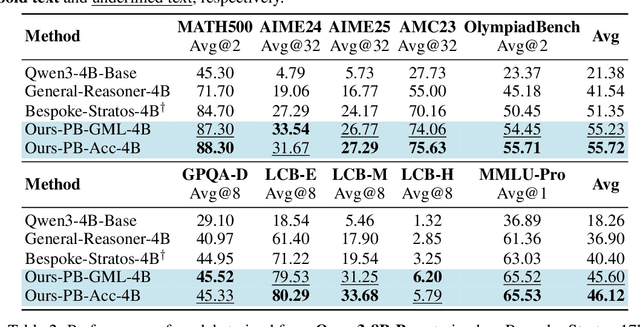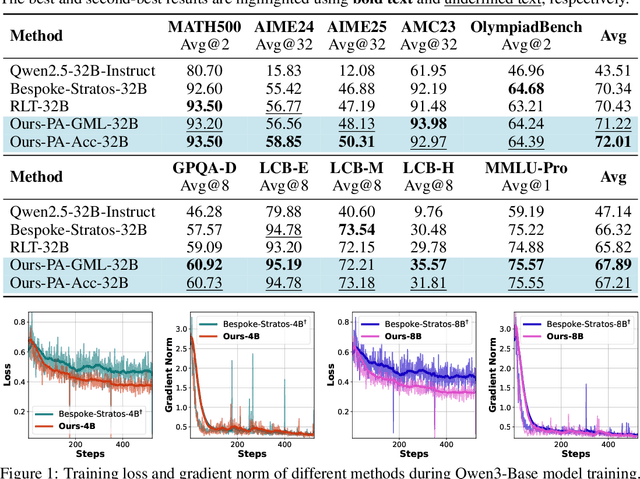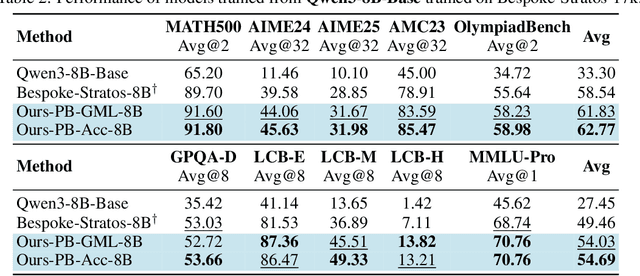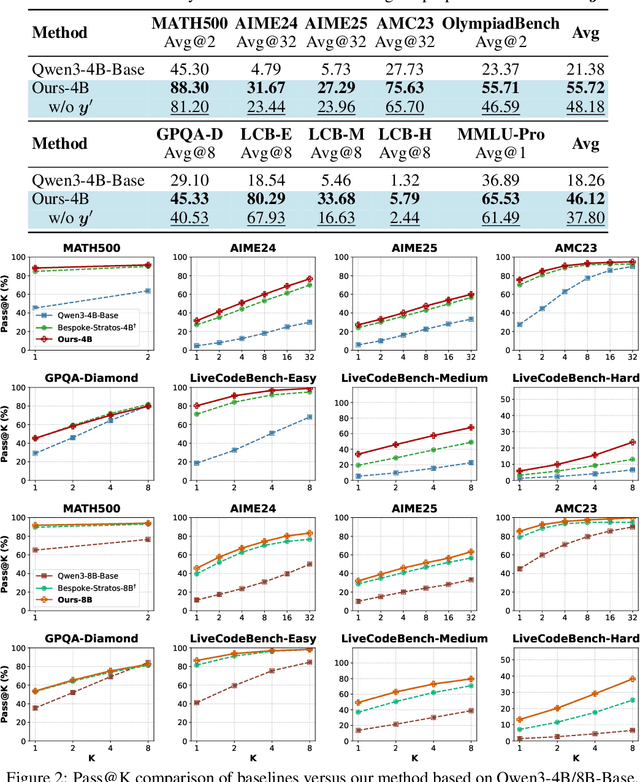Tianyu Pang
Defeating the Training-Inference Mismatch via FP16
Oct 30, 2025Abstract:Reinforcement learning (RL) fine-tuning of large language models (LLMs) often suffers from instability due to the numerical mismatch between the training and inference policies. While prior work has attempted to mitigate this issue through algorithmic corrections or engineering alignments, we show that its root cause lies in the floating point precision itself. The widely adopted BF16, despite its large dynamic range, introduces large rounding errors that breaks the consistency between training and inference. In this work, we demonstrate that simply reverting to \textbf{FP16} effectively eliminates this mismatch. The change is simple, fully supported by modern frameworks with only a few lines of code change, and requires no modification to the model architecture or learning algorithm. Our results suggest that using FP16 uniformly yields more stable optimization, faster convergence, and stronger performance across diverse tasks, algorithms and frameworks. We hope these findings motivate a broader reconsideration of precision trade-offs in RL fine-tuning.
Nonparametric Data Attribution for Diffusion Models
Oct 16, 2025Abstract:Data attribution for generative models seeks to quantify the influence of individual training examples on model outputs. Existing methods for diffusion models typically require access to model gradients or retraining, limiting their applicability in proprietary or large-scale settings. We propose a nonparametric attribution method that operates entirely on data, measuring influence via patch-level similarity between generated and training images. Our approach is grounded in the analytical form of the optimal score function and naturally extends to multiscale representations, while remaining computationally efficient through convolution-based acceleration. In addition to producing spatially interpretable attributions, our framework uncovers patterns that reflect intrinsic relationships between training data and outputs, independent of any specific model. Experiments demonstrate that our method achieves strong attribution performance, closely matching gradient-based approaches and substantially outperforming existing nonparametric baselines. Code is available at https://github.com/sail-sg/NDA.
Imperceptible Jailbreaking against Large Language Models
Oct 06, 2025Abstract:Jailbreaking attacks on the vision modality typically rely on imperceptible adversarial perturbations, whereas attacks on the textual modality are generally assumed to require visible modifications (e.g., non-semantic suffixes). In this paper, we introduce imperceptible jailbreaks that exploit a class of Unicode characters called variation selectors. By appending invisible variation selectors to malicious questions, the jailbreak prompts appear visually identical to original malicious questions on screen, while their tokenization is "secretly" altered. We propose a chain-of-search pipeline to generate such adversarial suffixes to induce harmful responses. Our experiments show that our imperceptible jailbreaks achieve high attack success rates against four aligned LLMs and generalize to prompt injection attacks, all without producing any visible modifications in the written prompt. Our code is available at https://github.com/sail-sg/imperceptible-jailbreaks.
Variational Reasoning for Language Models
Sep 26, 2025



Abstract:We introduce a variational reasoning framework for language models that treats thinking traces as latent variables and optimizes them through variational inference. Starting from the evidence lower bound (ELBO), we extend it to a multi-trace objective for tighter bounds and propose a forward-KL formulation that stabilizes the training of the variational posterior. We further show that rejection sampling finetuning and binary-reward RL, including GRPO, can be interpreted as local forward-KL objectives, where an implicit weighting by model accuracy naturally arises from the derivation and reveals a previously unnoticed bias toward easier questions. We empirically validate our method on the Qwen 2.5 and Qwen 3 model families across a wide range of reasoning tasks. Overall, our work provides a principled probabilistic perspective that unifies variational inference with RL-style methods and yields stable objectives for improving the reasoning ability of language models. Our code is available at https://github.com/sail-sg/variational-reasoning.
Language Models Can Learn from Verbal Feedback Without Scalar Rewards
Sep 26, 2025Abstract:LLMs are often trained with RL from human or AI feedback, yet such methods typically compress nuanced feedback into scalar rewards, discarding much of their richness and inducing scale imbalance. We propose treating verbal feedback as a conditioning signal. Inspired by language priors in text-to-image generation, which enable novel outputs from unseen prompts, we introduce the feedback-conditional policy (FCP). FCP learns directly from response-feedback pairs, approximating the feedback-conditional posterior through maximum likelihood training on offline data. We further develop an online bootstrapping stage where the policy generates under positive conditions and receives fresh feedback to refine itself. This reframes feedback-driven learning as conditional generation rather than reward optimization, offering a more expressive way for LLMs to directly learn from verbal feedback. Our code is available at https://github.com/sail-sg/feedback-conditional-policy.
Why LLM Safety Guardrails Collapse After Fine-tuning: A Similarity Analysis Between Alignment and Fine-tuning Datasets
Jun 05, 2025Abstract:Recent advancements in large language models (LLMs) have underscored their vulnerability to safety alignment jailbreaks, particularly when subjected to downstream fine-tuning. However, existing mitigation strategies primarily focus on reactively addressing jailbreak incidents after safety guardrails have been compromised, removing harmful gradients during fine-tuning, or continuously reinforcing safety alignment throughout fine-tuning. As such, they tend to overlook a critical upstream factor: the role of the original safety-alignment data. This paper therefore investigates the degradation of safety guardrails through the lens of representation similarity between upstream alignment datasets and downstream fine-tuning tasks. Our experiments demonstrate that high similarity between these datasets significantly weakens safety guardrails, making models more susceptible to jailbreaks. Conversely, low similarity between these two types of datasets yields substantially more robust models and thus reduces harmfulness score by up to 10.33%. By highlighting the importance of upstream dataset design in the building of durable safety guardrails and reducing real-world vulnerability to jailbreak attacks, these findings offer actionable insights for fine-tuning service providers.
Fostering Video Reasoning via Next-Event Prediction
May 28, 2025Abstract:Next-token prediction serves as the foundational learning task enabling reasoning in LLMs. But what should the learning task be when aiming to equip MLLMs with temporal reasoning capabilities over video inputs? Existing tasks such as video question answering often rely on annotations from humans or much stronger MLLMs, while video captioning tends to entangle temporal reasoning with spatial information. To address this gap, we propose next-event prediction (NEP), a learning task that harnesses future video segments as a rich, self-supervised signal to foster temporal reasoning. We segment each video into past and future frames: the MLLM takes the past frames as input and predicts a summary of events derived from the future frames, thereby encouraging the model to reason temporally in order to complete the task. To support this task, we curate V1-33K, a dataset comprising 33,000 automatically extracted video segments spanning diverse real-world scenarios. We further explore a range of video instruction-tuning strategies to study their effects on temporal reasoning. To evaluate progress, we introduce FutureBench to assess coherence in predicting unseen future events. Experiments validate that NEP offers a scalable and effective training paradigm for fostering temporal reasoning in MLLMs.
Adversarial Attacks against Closed-Source MLLMs via Feature Optimal Alignment
May 27, 2025Abstract:Multimodal large language models (MLLMs) remain vulnerable to transferable adversarial examples. While existing methods typically achieve targeted attacks by aligning global features-such as CLIP's [CLS] token-between adversarial and target samples, they often overlook the rich local information encoded in patch tokens. This leads to suboptimal alignment and limited transferability, particularly for closed-source models. To address this limitation, we propose a targeted transferable adversarial attack method based on feature optimal alignment, called FOA-Attack, to improve adversarial transfer capability. Specifically, at the global level, we introduce a global feature loss based on cosine similarity to align the coarse-grained features of adversarial samples with those of target samples. At the local level, given the rich local representations within Transformers, we leverage clustering techniques to extract compact local patterns to alleviate redundant local features. We then formulate local feature alignment between adversarial and target samples as an optimal transport (OT) problem and propose a local clustering optimal transport loss to refine fine-grained feature alignment. Additionally, we propose a dynamic ensemble model weighting strategy to adaptively balance the influence of multiple models during adversarial example generation, thereby further improving transferability. Extensive experiments across various models demonstrate the superiority of the proposed method, outperforming state-of-the-art methods, especially in transferring to closed-source MLLMs. The code is released at https://github.com/jiaxiaojunQAQ/FOA-Attack.
Reinforcing General Reasoning without Verifiers
May 27, 2025Abstract:The recent paradigm shift towards training large language models (LLMs) using DeepSeek-R1-Zero-style reinforcement learning (RL) on verifiable rewards has led to impressive advancements in code and mathematical reasoning. However, this methodology is limited to tasks where rule-based answer verification is possible and does not naturally extend to real-world domains such as chemistry, healthcare, engineering, law, biology, business, and economics. Current practical workarounds use an additional LLM as a model-based verifier; however, this introduces issues such as reliance on a strong verifier LLM, susceptibility to reward hacking, and the practical burden of maintaining the verifier model in memory during training. To address this and extend DeepSeek-R1-Zero-style training to general reasoning domains, we propose a verifier-free method (VeriFree) that bypasses answer verification and instead uses RL to directly maximize the probability of generating the reference answer. We compare VeriFree with verifier-based methods and demonstrate that, in addition to its significant practical benefits and reduced compute requirements, VeriFree matches and even surpasses verifier-based methods on extensive evaluations across MMLU-Pro, GPQA, SuperGPQA, and math-related benchmarks. Moreover, we provide insights into this method from multiple perspectives: as an elegant integration of training both the policy and implicit verifier in a unified model, and as a variational optimization approach. Code is available at https://github.com/sail-sg/VeriFree.
Lifelong Safety Alignment for Language Models
May 26, 2025



Abstract:LLMs have made impressive progress, but their growing capabilities also expose them to highly flexible jailbreaking attacks designed to bypass safety alignment. While many existing defenses focus on known types of attacks, it is more critical to prepare LLMs for unseen attacks that may arise during deployment. To address this, we propose a lifelong safety alignment framework that enables LLMs to continuously adapt to new and evolving jailbreaking strategies. Our framework introduces a competitive setup between two components: a Meta-Attacker, trained to actively discover novel jailbreaking strategies, and a Defender, trained to resist them. To effectively warm up the Meta-Attacker, we first leverage the GPT-4o API to extract key insights from a large collection of jailbreak-related research papers. Through iterative training, the first iteration Meta-Attacker achieves a 73% attack success rate (ASR) on RR and a 57% transfer ASR on LAT using only single-turn attacks. Meanwhile, the Defender progressively improves its robustness and ultimately reduces the Meta-Attacker's success rate to just 7%, enabling safer and more reliable deployment of LLMs in open-ended environments. The code is available at https://github.com/sail-sg/LifelongSafetyAlignment.
 Add to Chrome
Add to Chrome Add to Firefox
Add to Firefox Add to Edge
Add to Edge